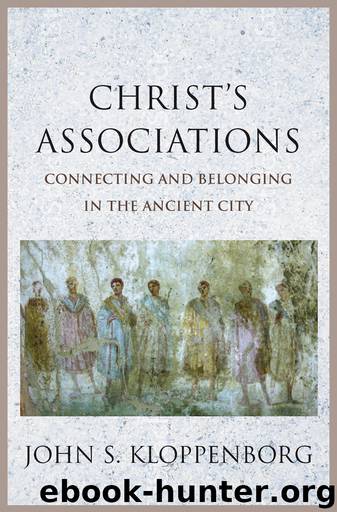Christ's Associations by John S. Kloppenborg;

Author:John S. Kloppenborg; [Kloppenborg, John S.]
Language: eng
Format: epub
Publisher: Yale University Press
Published: 2019-02-26T16:00:00+00:00
9
FUNERALS
Before Tertullian, almost nothing is said in the documents of Christ followers about how the dead are to be treated. First Thessalonians, Paul’s earliest letter, indicates that he may originally have given this group of gentile Christ followers the impression that none would die, Christ being expected to intervene before the “wrath that is coming” (1:10).1 As 1 Thess 4:13–18 shows, however, Paul had to invent the idea of the rescue of those believers who had died before the parousia by drawing on the hope of a bodily resurrection, well documented in Second Temple Judaism.
By the time that Paul wrote 1 Corinthians the terrain had shifted. The confidence that all would live to see the parousia had waned, although Paul himself still harbored the belief that he would be alive then. The issue was no longer now whether Christ followers would die but instead the nature of postmortem existence. In Philippians Paul expressed diffidence as to whether he would be alive or not at the parousia, and by 2 Corinthians (4:11–12, 5:1–6) a few years later he had embraced the likelihood of his own death. In Romans no trace remains of the eschatological confidence that Paul had voiced in 1 Thess 4:15 or 1 Cor 15:51, at least about his personal survival.
Christ followers died. How were their bodies treated? The lack of evidence of burials is not because they had dismissed death as inconsequential in light of their eschatological hopes, still less because they were unconcerned with the burial of their dead. It was probably for a much simpler reason: burials of Christ followers before the end of the second century are epigraphically invisible.2
An inscription can be identified as Christian by the use of a name that is identifiably Christian or the presence of formulae, terminology, or paralinguistic signs that point to the identity of the deceased as a Christ follower. Typically Christian names such as Petrus, Matthaeus, Iōannes, Georgios, and Anastasia/-us did not come into widespread use until the third or fourth century CE.3 Before that time Christ followers had pagan or Judean names. Distinctively Christian formulae such as in pace (in peace) begin to appear in the third century and eventually displaced the more usual pagan formula dis manibus (to the divine spirits), although for a time the two appeared together on Christian funerary inscriptions.4 Paralinguistic marks such as anchors, fish, doves, and chi-rho monograms (and eventually crosses) make their appearance in the late second and early third centuries.5 In rare instances the content of the inscription points to the deceased as Christian.6
Before the late second century and probably even the third, most of the funerary monuments of Christ followers were indistinguishable from pagan or Judean monuments. A grave marker from Thessaloniki identifies the deceased as “Apollonios son of Apollonios, presbyteros.”7 This might be the grave of a Christ follower, but it might also be a pagan or a Judean grave. The name Apollonios is a common pagan name, and the term presbyteros (elder) could be that of
Download
This site does not store any files on its server. We only index and link to content provided by other sites. Please contact the content providers to delete copyright contents if any and email us, we'll remove relevant links or contents immediately.
| Africa | Americas |
| Arctic & Antarctica | Asia |
| Australia & Oceania | Europe |
| Middle East | Russia |
| United States | World |
| Ancient Civilizations | Military |
| Historical Study & Educational Resources |
Empire of the Sikhs by Patwant Singh(22820)
The Wind in My Hair by Masih Alinejad(4915)
Rise and Kill First by Ronen Bergman(4595)
The Templars by Dan Jones(4573)
The Rape of Nanking by Iris Chang(4058)
12 Strong by Doug Stanton(3434)
Blood and Sand by Alex Von Tunzelmann(3082)
The History of Jihad: From Muhammad to ISIS by Spencer Robert(2518)
Babylon's Ark by Lawrence Anthony(2460)
The Turkish Psychedelic Explosion by Daniel Spicer(2260)
No Room for Small Dreams by Shimon Peres(2255)
Inside the Middle East by Avi Melamed(2255)
Gideon's Spies: The Secret History of the Mossad by Gordon Thomas(2253)
Arabs by Eugene Rogan(2208)
The First Muslim The Story of Muhammad by Lesley Hazleton(2167)
Bus on Jaffa Road by Mike Kelly(2052)
Come, Tell Me How You Live by Mallowan Agatha Christie(2049)
Kabul 1841-42: Battle Story by Edmund Yorke(1941)
1453 by Roger Crowley(1895)
